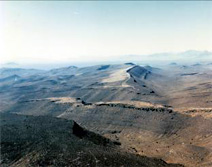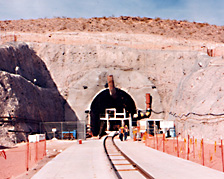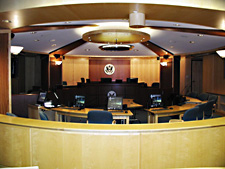Backgrounder on Licensing Yucca Mountain
Printable Version
On this page:
The Nuclear Regulatory Commission received an application from the Department of Energy on June 3, 2008, for a license to construct the nation's first geologic repository for high-level nuclear waste at Yucca Mountain, Nevada. The NRC's role is to assess whether the proposed facility meets NRC's regulatory requirements. The NRC staff's technical review, documented in its Safety Evaluation Report, is one part of this licensing process. The process also includes hearings before the NRC's Atomic Safety and Licensing Board, which will adjudicate challenges by a number of parties to the technical and legal aspects of the DOE application, and the Commission's review of contested and uncontested issues.
 Yucca Mountain Yucca Mountain, Nevada |
On March 3, 2010, DOE filed a motion with the Board asking to withdraw its application. The Board denied that request on June 29, 2010.
On appeal, the Commission found itself evenly divided on whether to overturn or uphold the Board's decision. During this time period, Congress had reduced funding for the NRC's review of the application, with no funds appropriated for fiscal year 2012 (and none in subsequent years). Recognizing the budgetary limitations, the Commission directed the Board to complete case management activities by the end of September 2011, and the Board suspended the adjudicatory proceeding on September 30. At the same time, the NRC staff completed orderly closure of its Yucca Mountain technical review activities. As part of this work, the NRC staff prepared three technical evaluation reports on DOE's application.
The D.C. Circuit Court of Appeals in August 2013 ordered the NRC to resume its review using existing funds from previous appropriations. The NRC staff completed the five-volume Safety Evaluation Report in January 2015. The staff also developed and published a supplement to DOE's Environmental Impact Statement, and conducted additional knowledge management activities to preserve information developed during its initial review. The adjudicatory proceeding remains suspended. However, the staff made adjudicatory documents publicly available on the NRC's online database system.
Background
The Nuclear Waste Policy Act of 1982 directed DOE to site, construct and operate a geologic repository for high-level waste. The Environmental Protection Agency was responsible for developing radiation protection standards for a repository. The NRC was responsible for developing regulations to implement EPA's standards and would regulate geologic disposal of the waste. In 1987, amendments to the act directed DOE to focus its work solely on Yucca Mountain, about 100 miles northwest of Las Vegas in Nevada's Nye County. DOE determined in 2002 that Yucca Mountain would be a suitable location for a repository. Congress and the President endorsed that decision, and DOE was directed to submit its license application.
High-level nuclear waste consists primarily of spent fuel from the nation's commercial nuclear power plants. It also includes spent fuel from U.S. Navy reactors and some waste generated during the development of nuclear weapons. The proposed repository would hold 70,000 metric tons of waste. This amount would include 63,000 metric tons of commercial spent nuclear fuel. More than 77,000 metric tons of commercial spent fuel are in temporary storage at nuclear power plants and decommissioned facilities across the country as of the end of 2016.

Licensing Review Process
Docketing Review and Environmental Determination
When DOE submitted its application in 2008, the NRC staff took an initial look to see if it was complete enough to docket and begin a thorough technical review. At the same time, the NRC staff began reviewing DOE's environmental analysis. On Sept. 8, 2008, the agency docketed the application and adopted DOE's environmental impact statements, noting more analysis was needed on some specific groundwater impacts.
Licensing Review
 Entrance Tunnel at Entrance Tunnel at
Yucca Mountain |
Once the application was docketed, the NRC's technical staff began a detailed and comprehensive review. This review involved NRC staff and contractor employees with expertise in many technical and scientific disciplines. They were experts in geochemistry, hydrology, climatology, structural geology, volcanology, seismology and health physics, as well as chemical, civil, mechanical, nuclear, mining, materials and geological engineering. The Center for Nuclear Waste Regulatory Analyses in San Antonio, Texas, the NRC's federally-funded research and development center, provided technical assistance.
As part of its review, the NRC staff asked for more information from DOE regarding the application. These requests and DOE's responses are publicly available, unless they contain sensitive security, privacy, or proprietary information.
The NRC staff published the final volumes of its Safety Evaluation Report in January 2015. In the Safety Evaluation Report, the NRC staff found that DOE's license application met the regulatory requirements for the proposed repository, with two exceptions: DOE had not obtained certain land withdrawal and water rights necessary for construction and operation of the repository. The NRC staff therefore recommended that the Commission not authorize construction of the repository until, among other things, these regulations were met, and a supplement to DOE's environmental impact statement was completed. After DOE declined to complete the supplement and deferred to the NRC, the Commission directed the NRC staff to develop the supplement. This supplement was completed and published in early 2016.

The Adjudicatory Process
 ASLBP Hearing Room in ASLBP Hearing Room in
Rockville, Maryland |
NRC adjudicatory hearings are conducted by the Atomic Safety and Licensing Board Panel, which is composed of administrative judges who are lawyers, engineers and scientists.
After docketing the application in 2008, the NRC published a notice of hearing and opportunity to participate in the hearing. The Panel appointed multiple Boards of three judges each to hear a variety of legal and technical contentions regarding the Yucca Mountain construction authorization application. The Boards admitted approximately 300 contentions before the proceeding was suspended on Sept. 30, 2011. If the adjudication were to resume, one or more Boards would hear evidence and issue decisions on admitted issues contesting DOE's application or the NRC staff's decision to adopt the DOE environmental impact statement. Parties may ask the Commission to review these Board decisions. The Commission's final decision may be appealed to a U.S. Court of Appeals.
A Board could also hold "limited appearance" sessions to allow members of the public to make brief oral statements about the proposed repository, and may invite the public to submit written statements.
If the NRC were to authorize construction of the Yucca Mountain repository, before beginning to operate the facility, DOE would have to update its application to request NRC approval to receive and possess high-level waste at Yucca Mountain. This application would be subject to similar technical review and hearing processes as the construction authorization application.
Additional information on the regulation of high-level nuclear waste is available on the NRC website.
Licensing Support Network
Under the Commission's rules, a hearing on DOE's application is required in the public interest before the Commission decides whether to authorize construction. In anticipation of the large number of technical documents related to the application that would be produced by DOE and the other parties, the NRC began preparing for the adjudicatory process long before DOE submitted its license application. The NRC created a Web-based Licensing Support Network, which was intended to be primarily a discovery tool. At the time the application was submitted, the LSN included over 3.6 million documents the parties had designated as relevant to the proceeding. Some of these were expected to be entered into evidence during the Yucca Mountain evidentiary hearings. The NRC deactivated the network in 2011. The parties submitted their documents to the Secretary of the NRC and these documents were held in storage. When work resumed in 2013, the documents were loaded into NRC's Agencywide Documents Access and Management System to allow access by NRC staff working on the Safety Evaluation Report. The Commission directed the NRC staff to make these documents publicly available, and the staff launched a new LSN Library in August 2016. The next year, the staff consulted the parties to the adjudication about ways to use these documents should the process resume.
Regulations
The NRC's regulations can be found in Title 10, Code of Federal Regulations. The primary regulations relevant to the Yucca Mountain review and hearings include:
- 10 CFR Part 2 – Agency Rules of Practice and Procedure;
- Subpart J, Procedures applicable to proceedings for the issuance of licenses for the receipt of high-level waste at a geologic repository, and
- Appendix D, Schedule for the proceeding on considering construction authorization for a repository.
- 10 CFR Part 51 – Environmental protection regulations for domestic licensing and related regulatory functions (10 CFR 51.67 and 51.109).
- 10 CFR Part 63 – Disposal of high-level radioactive wastes in a geologic repository at Yucca Mountain, Nevada
References
More information about the NRC's review of the Yucca Mountain application, including DOE's application and the NRC staff reports, is available on the NRC website.
June 2018

Page Last Reviewed/Updated Monday, June 18, 2018